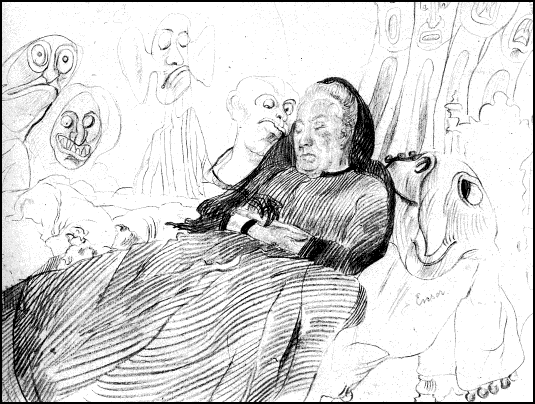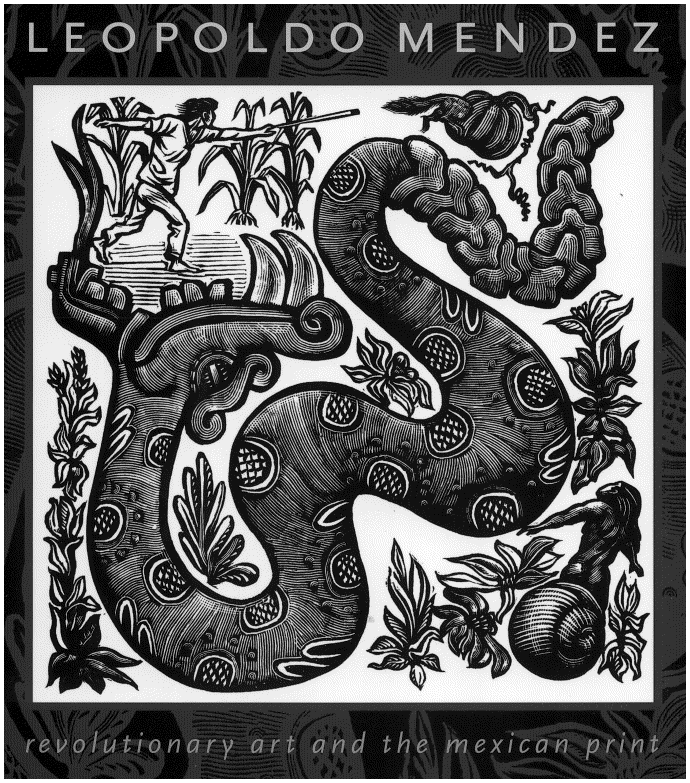
Leopoldo Méndez
Revolutionary Art and
The Mexican Print
Deborah Caplow
(University of Texas Press)

The artists of Mexico who lived through the ten-year Revolution were lucky. Not only did they survive upheaval, starvation, and the ruination of the country, but then they had the chance to experience the glorious artistic explosion that followed.We are speaking here of the years from 1920 to 1940, the time of Diego Rivera, David Siqueiros, José Orozco, Frida Kahlo, and the talented practitioners of Mexican engraving: Jean Charlot, Ramón Alva de la Canal, Pablo O'Higgins, and, probably the greatest of them all, Leopoldo Méndez.
As opposed to the politically and socially castrated American artists of the 20s, Rivera, Siqueiros, Méndez et al were deeply involved in the politics of their country, if not the world. Many were also involved in government projects to bring Art to the People. In the United States, and belatedly, this was administered by the WPA. In Mexico, it was brought about through the ægis of the Ministry of Education. Méndez himself spent a year or so as a teacher in villages of Central Mexico.
His main shtick, there in the sticks, was to get rid of Oscar Wilde's notion of "Art for Art's Sake." Art was, as he and Rivera and Siqueiros saw it, to free the workers, to lighten the burden of the campesinos, to uplift the poor, to unburden the rich of their excessive wealth.
Méndez, Ms. Caplow convinces us, was a dedicated printmaker and painter, a self-sacrificing revolutionary, a loyal comrade, and a good friend. He comes across as self-effacing, dedicated, more interested in communicating the evils of greed and violence rather than, like Rivera, pumping up his own balloon. His most moving prints are not the sometimes crude caricatures of captains of warfare and industry, but views of the humble peasant, the worker in the field, the poor drudges in the factories, the scattered heirs of Emiliano Zapata.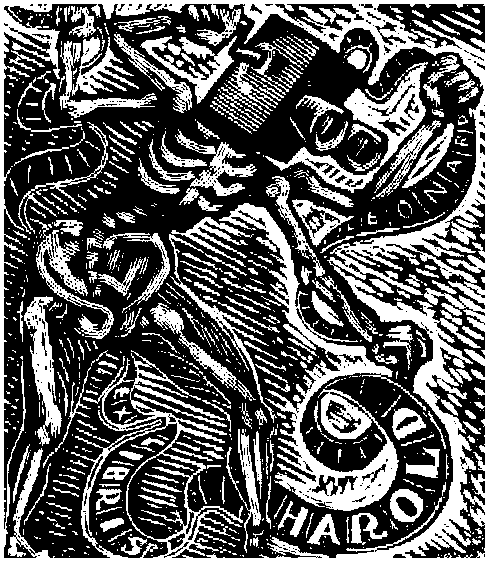 He also comes across as a trooper, a charmer, a persuasive writer. During the Depression, he made his first trip to America, and recalled the wonder of being approached by a poor gringo in Arizona:
He also comes across as a trooper, a charmer, a persuasive writer. During the Depression, he made his first trip to America, and recalled the wonder of being approached by a poor gringo in Arizona:I remember a man, tall and strong, who came up to us on the street, saying, "I haven't had breakfast. I haven't eaten. Yesterday I had work and today I don't." Later he explained to us, "I dared to approach you because you are Mexican. My countrymen don't like me and won't give me anything."
On the way north, he tells of a surprising find: "The wind brought us the miasma of a nearby cadaver. With a lantern we went to look for it and ..."
I was astonished by the spectacle of a dead dog in a state of decomposition, covered by butterflies with silvery wings, carnivorous butterflies that were devouring it. What a shame! I should have made a drawing with the fresh impression of this sight. It was like a dream.
In later years, what with the cold war and all, Méndez and his fellow artists were deemed too dangerous to be allowed to travel in the United States. He died in 1969, and a friend, Maples Arce, wrote, "he possessed the precious gift of sincerity, constantly reflected in his conduct and his work."
Leopoldo Méndez was always a congenial companion; he had a peaceful nature, without affectation or roughness, and he was frank without falling into rudeness.
"An ingenuous grace," Arce concluded, "brought him close to popular culture, and he was always a man of the people."
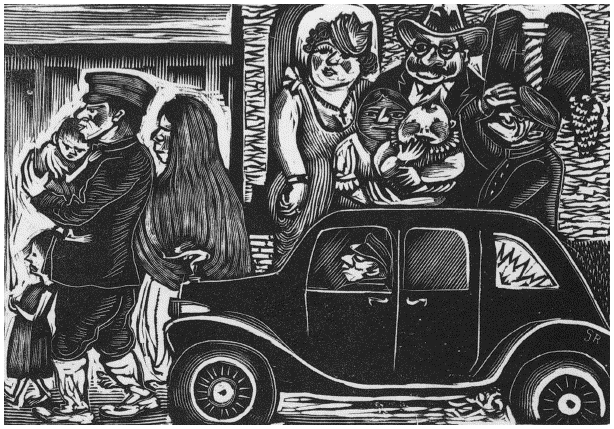
Airborne
The New Dance
Photography
Of Lois Greenfield
Designed by William A. Ewing
(Chronicle Books)Lois Greenfield specializes in stark black-and-white photographs of dancers. But it's not ballet members, locked in rigid steps, in tutus. Rather --- it is dancers suspended (through the magic of photographs) in mid-air, human figures reflected back on each other, shadows and moves that --- for this reviewer --- redefine bodies; in this case, beautiful, elegant bodies.William Ewing, the book's designer, states that in his visit to one of her shooting sessions, he expected that he would see that "the dancers appear to have lifted themselves into the air, waited for the photographer to snap the shutter."
It was not so, for
I could see nothing in front of me that remotely resembled a Greenfield image; all I saw were heavy, sweating bodies thudding about, the strenuous movements accompanied by sharp exhalations of breath as they landed.
He goes on,
I watched the dancers repeat each take with minor variations according to Greenfield's directions but the action never seemed to coalesce into the elegant, ordered motif I was expecting.
There are over 100 shots in Airborne, and they not only redefine bodies, they do the same to the art of dance, and the art of photography. We might say that what we have here are "motion pictures" --- Greenfield stretching the art of still-life (and still life photography) so that there is in the images a powerful frozen motion that --- at times --- seems to make the dancers dance right off the page for us. Indeed, the dancer and the dance become as one.
Greenfield started out twenty-five years ago as photographer for The Village Voice, Rolling Stone, Time and Newsweek --- but it was her work for Dance Magazine that brought her into this new world of plastic form.
William A. Ewing and Daniel Girardin, in their commentary, take us through the evolution of Greenfield's work --- from working for others, then participating in "a whole new vocabulary and grammar of dance..." Once she set up her own studio, she began work on her own. According to the editors, in this work, she has established six styles of photography --- including "the attributes of a dancer," the use of "literal choreographic material," and full improvisation. As one goes through Airborne, it seems that these categories might well be a bit arbitrary, but...no matter. What Chronicle Books has created here with Ms. Greenfield is a whole new vocabulary of dance, of black-and-white photography, of motion, of the frieze (read the "freeze") of elegant bodies, of a unity of form and function that goes well beyond description.
Some of us, for various reasons, are not to interested in people "jumping around on the stage to the music of Tchaikovsky," as one critic described it. But to see these sinuous creations, moving so stunningly about on the page is to experience a model that defies the old concepts of "dance" and "ballet."
British Wood-Engraved
Book Illustrations 1904 - 1940A Break with TraditionJoanna Selborne(Clarendon Press/Oxford)The author tells us that wood-engraving is most closely allied to books and book-publishing. Other forms, such as engraving, etching, and lithograph must be printed separately, on a different press. "Cut or engraved woodblocks, on the other hand, being in relief, can be printed on a orthodox press simultaneously with a page of type and, with careful cutting, can be made to harmonize with it." During the 19th Century, wood-engraving was used solely for illustration, but, in the early part of the 20th Century, British artists began to experiment with "an adventure of discovery," creating an autonomous medium. The great split was between those who wanted wood-engraving to be on a level with etching and other graphic arts, and the pure artists developing their own singular craft.
Wood-
engraving was largely hidden from the general public, appearing only in limited editions of books, and in rare exhibitions. However, in the 1930's it began to be seen as a popular art form, with commercially produced books, magazines, and advertisements. Its artistic masters --- Paul Nash, Robert Gibbings, Gertrude Hermes, Blair Hodges-Stanton, and the astonishing Eric Gill --- were not influenced by continental or American engravers, she tells us, but developed their own technique and standards in isolation from the rest of the art world. Between the wars, the wood-engraved book illustration was essentially a British phenomenon, calling on an English "pastoral or literary tradition," from the likes of Thomas Bewick, William Blake, Joseph Crawhall, and the painter William Nicholson (who, in turn, was influenced by Toulouse-Lautrec and the Japanese masters.) Ms. Selburne explains the primary difference between wood-engraving and woodcutting:
Woodcut blocks, she explains, "often reveal the grain of the wood," and are "coarser and more robust." (The wood of choice for wood-engraving blocks is boxwood, being very hard and fine grained, with a "smooth and durable printing surface." The prints tend to be small, because "the diameter of the trunk is never large.")
White-line wood-engraving is like drawing with chalk on a blackboard: lines and textures which are incised with engraving tools into the end-grain of hardwood appear white when an impressions is taken from the inked surface of the block...The hardness of the wood enabled the engraver to achieve much greater detail and tonal refinement than is possible with woodcutting...in which the design is cut on the plank of softer wood with a knife or gouge.
Pioneering wood-engravers such as Eric Gill, David Jones, Philip Hagreen are well-represented here: in fact, this 400+ page volume contains over two hundred plates, running from the pioneers to pre-WWII artists such as Agnes Miller Parker, Mary Groom, Dorothea Braby, and Blair Hughes-Stanton.
The text is nicely informed, and the wood-
engravings so gloriously presented that we were thinking that fine books like this should be outlawed. You pick it up to leaf through it, to start a review, and two hours later, dazed, you lay it down, regretfully, because you feel guilty at spending yet another minute without writing on a subject as abstruse as this one --- with such stupendous visual rewards. In fact, the best thing I can think of to do with British Wood-Engraved Book Illustration is to tear the son-of-a-bitch to pieces --- not in rage, but in love. To cut out Robert Gibbings illustration for "Lamia" (man, woman, palm-trees). Or to eviscerate pages 231 - 239 and extract Robert Gill's lovely, lurid representations of "The Song of Songs." Then to gouge out pages 101 - 104 and mount Paul Nash's "Three Carts" (see Fig. 2 above) on the refrigerator door. Maybe, as well, to brutally excise Plates 82 - 85 --- being illustrations by John Farleigh of Shaw's play, The Adventures of the Black Girl in her Search for God --- to stick them on the wall behind the computer to contemplate again, and again, and yet again.
And, best of all, to amputate the pages containing "The Nuptials of God" (see Fig. 1 above) by Eric Gill such a delicious take-off. We'd haul it down to The Blow-Up Photo Shoppe, turn it into a six- by twelve-foot poster to hang at the top of the bed, so we can see it, in love with it, as we are with love ... every day, and every night.
Art
Over 2,500 Works from
Cave to Contemporary
Foreword by Ross King
(DK)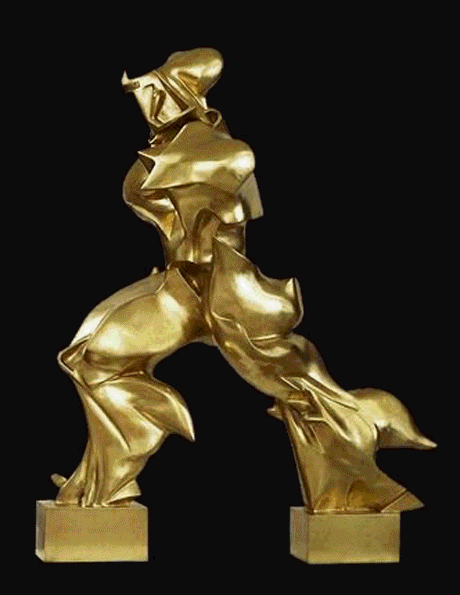 If you drop it, it'll break your toe. That happened to me once. I didn't break the book --- a fine volume on wood-engraving from Oxford University Press --- but my toe grew to be nice and purple, like a grape.
If you drop it, it'll break your toe. That happened to me once. I didn't break the book --- a fine volume on wood-engraving from Oxford University Press --- but my toe grew to be nice and purple, like a grape.It was lovely: the book, not my toe. I had a chance to spend a goodly time with it, a few days at least. Almost worth it.
It's best not to drop Art. You might lose more than a toe in the process. It's over six hundred pages, tall, thick paper, heavy-duty. Ross King is here. If you like him (his book on Michelangelo was a show-stopper) don't hold your breath. King's essay barely weighs in at 600 words, in five-point type, on a quarter-section of the first page (the rest taken up by the wavy sun-moon-stars out of Van Gogh).
King is of the art-should-shock and make-you-a-better-person critical school, but don't you pay that no mind, as my beloved mother would say. If you've ever been to the Barnes Foundation, you might think differently. The paintings that stay with me fifty years after are not the drab Chiricos or Soutine's hanging, eviscerated dogsbodies ... nor even the sole dark Rembrant or the imposing Tintoretto ... but the plump-breasted, wispy-haired ladies by Renoir, the funny, chunky Cézannes ... and Matisse's elongated dancing figures over the windows of the main studio, commissioned by Barnes himself.
Art is heavy, in all senses of the word, according to King, and as an example he offers up Guernica. Well, I say it's a fine example of political art, but not necessarily art art: just a huge block of black and white canvas, sitting there, balefully ... glaring at you. Picasso's early stuff I suspect is far better, along with some of the things he tossed off near the end of his life: I've always been fond of his immensely popular sketch of a wobbly Don Quixote alongside a dumpy Sancho Panza.
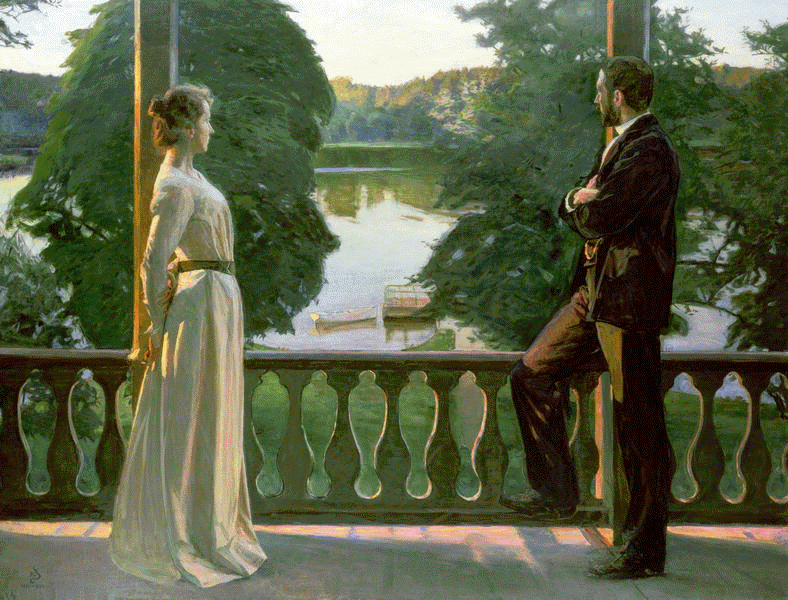
The prejudice in Art is shown by the artists who get more than a eighth or a quarter or a half-page. Seurat gets five which is OK by me: anyone who would drive themselves nuts by dividing their paintings into seven-million colored dots deserves some space. My beloved Matisse only merits three pages, with the atypically sad Sadness of the King getting top billing. Picasso rakes in the sweepstakes with eight full pages, four dedicated to Guernica alone. Stupendous Modigliani gets only one, Soutine --- no dead dogs allowed --- a half-a-page.My other hero, Henri Rousseau --- they call him a primitive --- gets but a page, while that overblown Salvador Dali is awarded three-and-a-half ... including a lobster atop a telephone. The editors assure us that "both hard-shelled objects, lobsters and telephones held powerful sexual associations for Dali." Waiter, hold the Lobster Newberg.
The big bore Robert Rauschenberg gets three pages, Jasper Johns two, and that dunce Andy Warhol two too many, along with his cynical quote "Making money is art, and working is art, and good business is the best art."
One of the editors, don't ask me who, in the chapter entitled "Post-war Europe" --- which war, there've been so many? --- tries to define Existentialism in sixty-five words. War also gets full billing on pages 510 - 511, fifteen paintings and a bas-relief squashed into two pages, in one of those all-encumbering theme pages ("Myth and Legend," "Animals," "Nudes," "Portraits.")
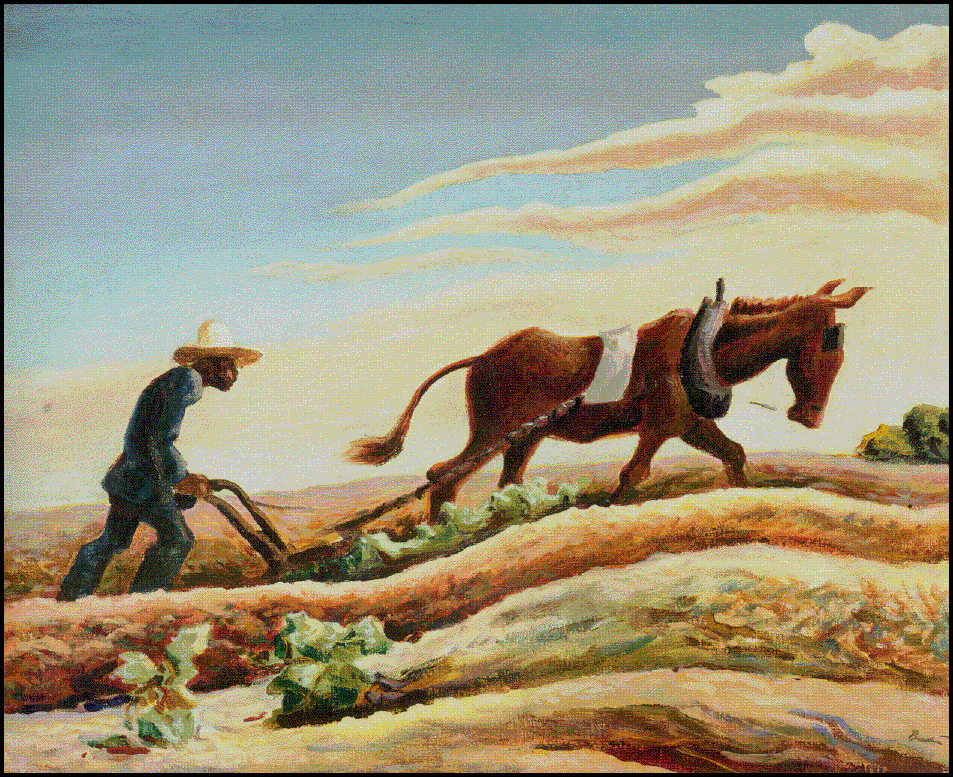
The eccentric but wonderful Thomas Hart Benton is mashed into but 1/6th of a page, just below Grant Wood and across from Edward Hopper. Semi-realist Georgia O'Keeffe merits a little over a half-a-page, and, she tells us, "Nothing is less real than realism." Diego Rivera is shrunk down to 2-1/2 paintings whereas wife Frida gets a full page. A box on page 499 tries to cram the whole of the "Mexican Revolution 1910 - 1920" into twenty words.Jackson Pollock's inchoate drip-ery gets five pages, although he has to share a part of page 503 with Peggy Guggenheim who is quoted as saying that he was "the strongest painter of his generation." Stronger than what?
As far as we are concerned, you can quit this volume when you get to page 500 ... Abstract Expressionism, Pop Art, Kinetic Art, Minimal Art, Conceptual Art ... each one sillier and sillier. And by the time you arrive at Superrealism, Neorealism, Sacrorealism, Synchrorealism, Pantheocreaticrealism ... why, you might just as well hang it up. The lobster, that is.
In my book, the only one worth his salt from those years is Ad Reinhardt who, in the ultimate decade of his life, only painted variations of black. "I am simply making the last paintings that can ever be made," he is reported to have said.
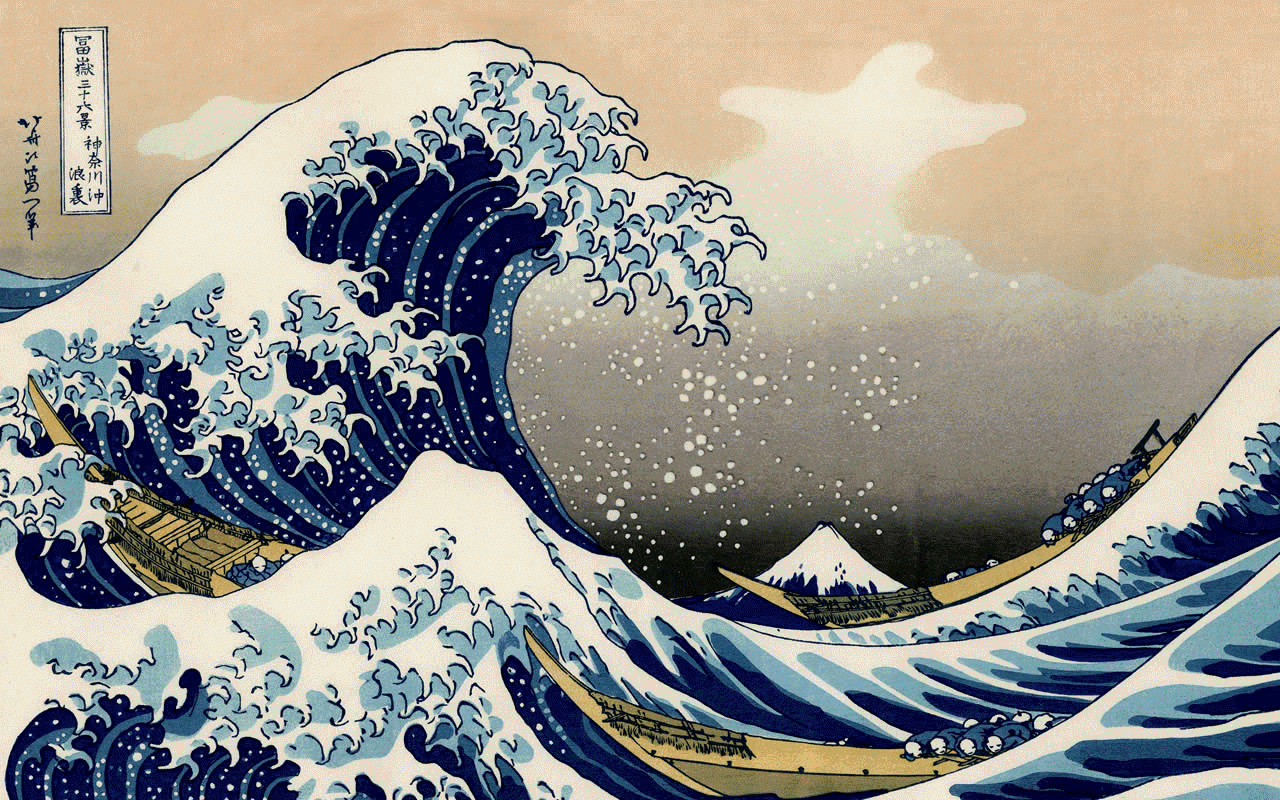
Art offers an interesting take on a way to look at paintings: look at the patterns; follow the lines; recognize the balance of elements. But don't look at Art for the art. It will never be the be-all because great paintings have to be seen as they are, not as they are reproduced. We have here massive art works reduced down by 90 - 95%, leaving only hints of what we are missing.And, that is, perhaps, the value. For you will see --- among the more than 2,500 paintings, drawings, sketches, sculptures, buildings shown here --- something that grabs your attention, something that, if you are lucky, will lead you to the source.
Wine glasses by Patrick Caulfield. The original Laocoön, the three figures enrapt by those snaky snarky creatures. Arabesque tilework --- which I must have on my dormer wall --- from at the Masjid-i-Jomeh mosque in Isfahan, Iran.
A windblown horse with groom, by Zhao Mengfu, now resting in Taipei. Bellini's very prissy Doge Leonardo Loredan. Giotto's very green Christ in Florence. Françoise Rude's very rude Liberty. Boccioni's very husky Unique Form of Continuity in Space [See Fig. 1 above].
Hokusai's famous and stupendous wave, cresting at the British Museum. Van Gogh's colorful, lovely, tiny, lively bedroom at Arles, now no longer in Arles, but in Chicago. Richard Bergh's stately Nordic Summer Evening complete with a dim Nordic sun, hidden, hanging hidden there in the Goteborgs Konstmuseum. Rousseau's leafless walk in the forest. And ... Lord Love Me ... Modigliani's stupendous Nude with Necklace, the nude (and the necklace, some necklace!) hanging together now at the Guggenheim in New York, where, some day soon, before I pop off, I must, somehow, get to see.
The Crucifixion in
American Art
Robert Henkes
(McFarland)The earliest paintings are from the mid 1700s, and include paintings of John Valentine Haidt, Benjamin West, and John Trumball. The three shown are obviously in the European Renaissance mold.The only famous artist represented in the 19th Century is John Singer Sargent, whose Tyrolese Crucifix is in watercolor, and not bad. The oddest from these early years are those of Fred Holland: platinum photograph prints in which he has mounted himself on the cross complete with long hair, nails (none, presumably, penetrating the flesh), and a saintly, nicely gowned Mary along with selected disciples at the base.
But the main delights in this book come from the first fifty years of the twentieth century. The primitive paintings from William H. Johnson are lively and painful and, can we use the phrase? --- filled with jazz. Later works, including Jonah Kiningstein offers a slashing death's head, and John Talleur's Burial are the stuff of nightmares.
There are a hundred or so photographs here, with short commentary on all the artists. The pity is that all the shots are black-and-white, so that we miss some of the true power of what they are representing.
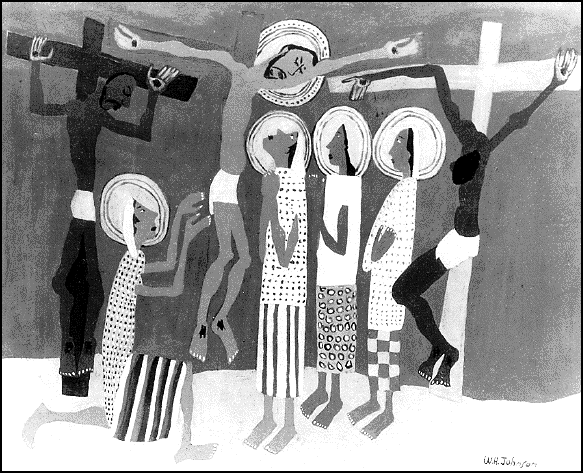
The Texas Post Office Murals:
Art for the People
Philip Parisi
(Texas A&M University Press)
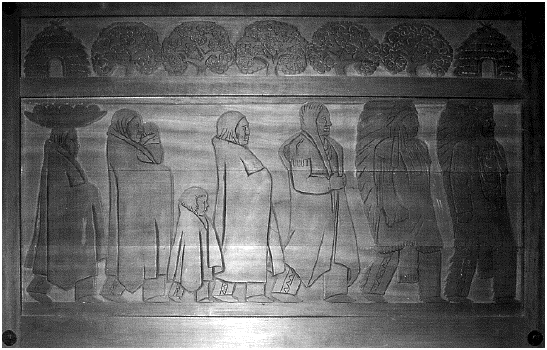
Francis Biddle, friend to Franklin D Roosevelt and collector of fine art, suggested that the New Deal works program --- Works Project Administration --- should include jobs for fine artists. "Hell, they've got to eat just like other people," he said.He explained that the muralists Rivera, Orozco, and Siqueiros had given "visual messages of hope" to Mexicans and that a similar experiment in America could "express in living monuments the social ideals that you are struggling to achieve."
So the Public Works of Art Project was established, and later, under the Treasury Department, increased vastly in scope as the Section of Fine Arts. One percent of the budget of all new post offices was set aside for murals. Competition was anonymous: color sketches would go to a local citizens committee for prescreening, and those deemed worthy would be forwarded to Washington for final judging.
As Parisi points out, the selection process "gave all competing artists, regardless of their ethnicity or gender, a fair opportunity... to land a contract."
As a result, the Section of Fine Arts stood out from other New Deal art programs, not only because of the competition for commissions that ensured work of the highest quality possible but also because of the democratic nature of the selection process.
§ § §
This volume consists of sixty-nine of the 106 artworks that appeared in Texas post offices. The reproductions in the book are mostly in color, and are of fine quality. Eight murals that have been destroyed or put into storage are represented by photographs drawn from the archives of the Section of Fine Arts.
Some of this government-sponsored art is genuinely powerful stuff. Tom Lea's "Stampede" in Odessa is a wonderful picture of confusion, a forest of horns, lightning, falling cowboys, and bovine madness: the lead bull is rising up red-eyed, looking as if he will be jumping out at us as we wait patiently in line for our stamps.
The post office in Baytown got "Texas" [Fig. 3] an allegorical picture of a hunky bare-chested god, complete with wings, about to cast an airplane out over the box-holders. The committee that awarded the contract to artist Barse Miller got the willies, found his heroic figure perhaps a bit too heroic. He was invited to show a little less crotch. He accomplished this by enlarging the 19th Century train at the bottom of the picture and by upping the loin-cloth to a more seemly navel level.
One of the best examples of the impact of community fears is the image [Fig. 2] by Frank Mechau. It appears in the Brownfield post office. It is supposed to be one of cowboys dousing a prairie fire by, yetch, dragging a recently butchered cow across the fire line.
The local postmaster was not impressed by the early sketches, even though the Cow Body Drag was the true-to-
life methodology of dealing with such blazes (dead cows were easier to come by than fire trucks). In addition, he opined that "the cowboys do not look like our kind. They look to [sic] much like Spaniards." Mechau responded by saying that
They might well look greasy after fighting fire and smoke for a few days. How ever, I shall see to it that they have a Nordic profile and a blue eye shining through the sweat.
That some of these murals created controversy is not so unusual. What is strange is that so many got mounted despite possible controversy. Along with the usual husky men in buckskins hewing wood and drawing water, there are a fair number of depictions of harsher, more grisly work --- murals probably inspired by the Mexicans that Biddle had referred to. There are depictions of workers welding heavy pipe, men sweating in the oilfields, wrestling with cattle, working the fields.
One by California artist Victor Arnautoff shows black men and women dragging huge cotton sacks behind them. The workers are stooped low to the ground, seemingly in the agony of their work. To underline the message for the proletariat, there is a mansion on the hill in the background, and, off to the right, a bare wooden hovel ... obviously the home of the workers.
§ § §
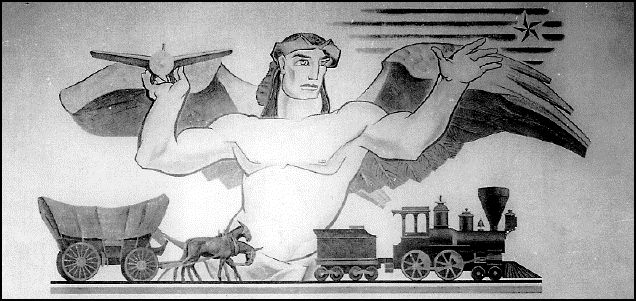
Despite being now inundated by Picasso, Dali, Cezanne and what one artist called "Jack the Dripper," I suspect there is a bit of New Realism in all of us. I think we all respond to Art with a Purpose, even if it is the merry Saturday Night Cowboy Dance, or the laborers in the sun: the hearty loggers, the stooped workers of the fields, cowboys herding and branding and surviving stampedes. It's the Muscle-and-Sweat School of Art. Good for the masses depositing their Postal Savings downtown, right? But there is no pure image in painting. It passes through the hands of artists, who necessarily shade the subject to match his or her own prejudices. Some of what appears here is as Biddle wanted it: "to give visual messages of hope." But artists are a noxiously independent lot, and we cannot help but feel their resentment in a government that many of them believed to be selfish, dangerous, and dying: the very government that, ironically, put them to work.
In our review of Wall to Wall America, an earlier book about WPA murals, we told of one in particular, Stefan Hirsch's Justice as Protector and Avenger. It was one that gave dyspepsia to the home folk in Aiken, South Carolina.
They went bananas over it because the figure of justice appeared to be a "mulatto" (not to be idolized in the deep South) and because there was a representation of "a burning house, a shyster lawyer freeing a prisoner from jail and a burglar pursuing his trade." A local judge questioned whether the mural was "a work of art or a monstrosity." An official of the PBA went to Aiken, took a gander, and subsequently authorized "the purchase of a tan velvet curtain on a drawstring...
to be placed over the mural --- so that it can be covered through court sessions and opened to the public on request." The author of Wall-to-Wall Art opined that the mural offended the people of Aiken because they much preferred Hollywood reality, or perhaps Mickey Mouse as that notorious roustabout, Steamboat Bill. It was "a phantom mural for a phantom people who didn't live in Aiken, South Carolina," the editor concluded.
The primary feeling left with readers of these books is one of awe. That a government agency could so generously support the arts without the fear that the artists would terrify the gentry, that the decorum of the state would be breached by a radical message plastered here or there in our post offices. Can you imagine the present administration giving carte blanche to a bunch of painters, offering them whole walls with which to decorate our daily world with not only the freedom but the wherewithal with which to do it?
Imagine that one coming out of present-day Washington. It boggles the mind.
As does the mot, mounted over the door of the El Paso post office, painted in capital letters by the artist Tom Lea:
O PASS OF THE NORTH
NOW THE OLD GIANTS ARE GONE
WE LITTLE MEN LIVE WHERE HEROES
ONCE WALKED THE INVIOLATE EARTH
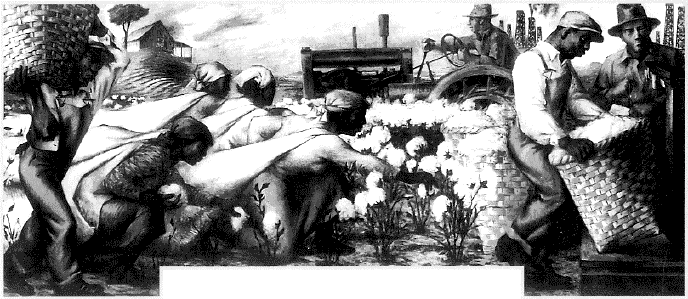
Go to the complete
reviewBetween Street
And Mirror
The Drawings of
James Ensor
<Catherine de Zegher
(The Drawing Center/
University of Minnesota)Journalist J.P. Hodin visited the Belgian artist James Ensor in 1948, and wrote the following:
Later, when I returned to Ensor's house, I found him sitting near the window, only half turned toward the door. He was wearing a soft black felt hat. His beautiful face with its regular features was rosy, and his bright forget-me- not- blue eyes were gazing across the room with a kindly expression. Not at me, yet slightly passive, tranquil, waiting. I stated the reason for my visit, raising my voice, for the expression of his face told me that he was hard of hearing. Behind the comfortable armchair stood Auguste [Boogaerts] with his little black cap and his Mephisto-like gaze. His face beamed with inward certainty, the reflected glory of his master's greatness, a self-confident limitation in contrast to Ensor's understanding gentleness.
Ensor pursed his lips before he articulated his words, as though tasting them first. We were strangers to each other. I knew that I would have to break the ice of this kindly detachment with my questions, or learn nothing.
On the walls hung countless small pictures of Ensor's. The room was filled with dark furniture; everywhere there was porcelain, big seashells and framed photographs. It was like being on a stage, translated into an Ibsen milieu.
On the table at Ensor's side stood his three last paintings. Auguste pointed at them emphatically. On one of the walls hung a portrait in dark tones reminiscent of Courbet, a work of Ensor's early period. On another wall was a larger painting in pastel colors --- pink and pale --- a stage decoration for Ensor's ballet "Love's Compass: The Flirting Marionettes."
In order to start the conversation, I said that I could well understand how difficult it was for the experts to classify his art. It was surreal because it was super-real long before the surrealists, and, at the same time, traditionally felt. It was symbolic in the conception of its motifs and impressionistic in the handling of the paint. It was expressionistic as a spontaneous representation of human emotions.
"I do not impose impressions," Ensor said in a soft, melodious voice. The smile on his face was warm and kind. "I attach no importance to labels. I don't like adjectives."
I mentioned that to me his art was so full of meaning and how unfortunate I thought the development of analytic-
constructive painting, which, because of its lack of meaning, has --- as André Gide so well said in his thoughts on Poussin --- become the symbol of our time. "Yes," Ensor nodded, "My art tends toward the literary. My pictures tend toward the outskirts of painting: But why generalize? It is possible to realize one thing or another, according to the impressions gained from one point of view or another. But it is too difficult to make a general rule."
I suddenly changed the subject, to surprise him out of his reserve. I referred to the restlessness of the time, the deep pessimism and nihilism that prevails everywhere, and I went on: "There are still people to be found who talk of progress, without recognizing that mechanized civilization has robbed us of our innermost strength and enslaved us."
"I see no evolution," Ensor said, pursing his lips. "I see nothing but a great uncertainty. And inquietude above all."
"Where will it all end?" I asked.
He shook his head. "I don't know. That probably lies outside our present power of comprehension."
He looked out of the window and I scrutinized him closely. How beautiful old men are, I thought, when their minds remain alive and harmonious, while old age exacts its due. I felt a burning desire to ask him about ultimate spiritual things. I risked it.
"Do you believe in life after death?"
"No," he said decidedly. Auguste smiled.
"And the meaning of death? Is it sufficient to regard it as something 'natural?"'
"It's very difficult...."
"Have you been tormented by the enigma of life?"
"Certainly. I have searched, yes, but not found; but perhaps this is an answer to your question: I am content --- I let myself be cradled by events. I have faith in major forces."
That's it, I said to myself; one gives way. Death is stronger. Perhaps this is wisdom, perhaps it is mere resignation?
When I told Ensor about my doubts, he gave me a lively glance and said, "You accord the individual too much importance. He has no particular significance."
Auguste had been listening impatiently for a long time and now he burst out, "The Master is not a philosopher! After all, he's a painter."
I would not let myself be put off. A quick answer for Auguste, "But there is philosophy in his pictures, not only painting!" And so to the next question for Ensor: "God --- how do you conceive of God?"
"God is a force. He is that which is strong." And, after a pause, "God is what we believe in."
Auguste threw in categorically, "The Chinese, think of the Chinese. It's evident, there are very many gods."
I nodded to him soothingly and said quickly to Ensor, for I felt that I was tiring him, "But why did you paint Christ in your painting of the entry into Brussels? And why Brussels?"
"I chose Brussels, but it might as well have been another place. And Christ..." Ensor said, pausing --- Auguste broke in: "The Master is a bad catholic but a great revolutionary."
"You should write a book about it," I retorted.
"I am waiting until others have made the mistakes."
It was impossible to get the better of that fellow!
"Christ," Ensor repeated, "is a very great figure. People have thought a great deal about this figure. The Christ is an inescapable symbol."
After these words, Ensor gazed into space for a long time without speaking. He looked at a small picture on the wall, two female figures, one in a red dress, the other in blue. "At first they were naked," he said, "but they were far from beautiful."
§ § § This gorgeous volume runs some 250 pages. It contains a few photographs of the artist, along with 150 or so of his sketches and drawings. The pictures are weird, strange, wonderful, horrible, odd, filled with Christs, goblins, ghosts --- and old women immersed in scary dreams [see below]. Ensor himself looks to be a sweet, unassuming man, but his self-portraits can be a little off-putting, too --- especially the ones showing his head turning into a skull.
